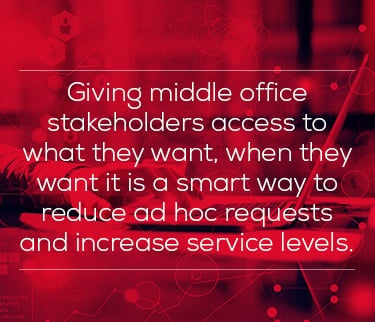How the self-service revolution is making the middle office more efficient.

In today’s society, customers expect an always-on, on-demand service. This cultural shift in expectations has seen industries change the way they deliver services.
For example, in years gone by viewers would have to wait until the TV shows they wanted to watch were scheduled for transmission. Viewers had no control and the broadcasters would dictate what shows could be watched and when.
But the rise of services like Netflix has turned this on its head. Consumers can now access the entertainment they want, on-demand, through a self-service platform. What’s more, this service is personalized according to each viewer’s preferences and requirements.
Data on demand
The self-service revolution can also be extended to the asset management industry. In fact, it is a crucial part of a middle office digital distribution strategy. Giving middle office stakeholders access to what they want, when they want it is a smart way to reduce ad hoc requests and increase service levels. In a complex world, this simple strategy makes sense.
But just like TV viewers, different middle office stakeholders want different things at different times.
-
The front office needs timely and in-depth analysis to show them what happened, why, and at what cost. It wants independent performance, attribution, and risk analysis on a daily basis with the ability to drill down into the details if necessary.
-
Sales and marketing teams need to tell the story of the investment process and how the overall strategy is working. Being able to show this data in a clear and visual way is essential when talking to clients.
-
Risk and compliance teams need to keep a close eye on activity and risk limits to make sure they stay within regulatory requirements. Analysis needs to focus on very specific details and accuracy is key.
But for the middle office, reactively responding to such ad hoc requests is like spinning plates. It is inefficient and time-consuming. It is also unproductive for the asset management firm as a whole, because the middle office then spends its time firefighting reporting and data issues rather than adding value.
Flexible self-service
The answer lies in self-service, giving stakeholders access to what they want, when they want it. In much the same way that an on-demand viewer can fast-forward through the adverts, binge watch a whole series, or just catch up on a few minutes of a show that had been missed, the middle office must give its stakeholders options.
The secret lies in the flexibility of the system and the interface it presents to users. The onus is on the middle office to bring in the data, process it, and make it available to all stakeholders as quickly and as accurately as possible. There also needs to be high-quality governance and transparency around the workflow and analysis so that end users can identify what they are looking at, and understand the process and methods that have been used to arrive at that point in time.
And once this job has been done, analysis and information should live on an accessible platform ready and waiting to be accessed by anyone, either through a flexible interface, or programmatically via a Web API.
Presentation is everything
The key is to have an interface that is fully customizable to the needs of each stakeholder. It must be intuitive, highly visual, and adaptable. Self-service also needs control, so administrative users must be able to create user roles and rules on what people can or can’t see and do. In practical terms, stakeholders need to have all their analysis dashboards in one place, whether it’s for performance, attribution, risk, or compliance. All organized in a structure that makes it easy to focus on what’s important to them. Sales and marketing users will want to see analysis differently to a performance expert, or a fund manager wanting detailed attribution analysis. Having the flexibility to present that information in a customized but controlled way adds so much value to the middle office.
The self-service play is all about moving towards a centralized processing and management workflow. When the middle office provides accurate data through customizable and easy-to-use dashboards, it allows stakeholders to get the details they need and get on with doing their job. And because they are no longer receiving multiple ad hoc requests, the middle office can focus on delivering better analysis and more accurate data.
Key takeaways:
- Giving middle office stakeholders self-service access to the analysis they want is more efficient for all parties.
- The middle office needs to be able to show that it can add value and help its stakeholders do their jobs more effectively.
- It needs to be able to provide the right data in the right format in a timely and accurate manner.
- The key is to provide an interface that is fully customizable to the needs of each stakeholder.
Learn more about how the middle office can deliver excellent service to its stakeholders in our eGuide: How can the middle office enhance its client service?
{{cta(‘f825d38f-c569-4e43-91b8-d9aa743e6d10’)}}